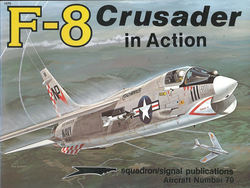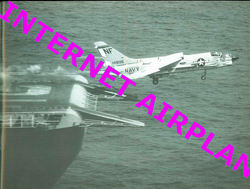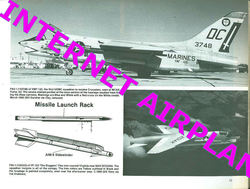



|
SQUADRON SIGNAL F-8 CRUSADER IN ACTION LTV USN VF USMC VMF
SQUADRON SIGNAL PUBLICATIONS AIRCRAFT NUMBER 70
BY JIM SULLIVAN. COLOR BY DON GREER. ILLUSTRATED BY KEVIN WORNKEY. (1985)
COLOR COVER: VF-211 ROADRUNNERUSS HANCOCK CV-19 MIG KILLER VIETNAM WAR
VF-51 USS BONHOMME RICHARD CVA-31 CATAPULT LAUNCH GULF OF TONKIN VIETNAM WAR 1970 FULL PAGE PHOTO
INTRODUCTION (CHANCE VOUGHT XF8U-1 CRUSADER PROTOTYPE, DALLAS FACTORY, DEVELOPMENT)
F8U-1 (F-8A) (CARRIER TRIALS USS FORRESTAL CVA-59, REFUELING PROBE ILLUSTRATION, VARIABLE INCIDENCE WING, VFAW-3 NAS MOFFETT FIELD, VF-211 NAS MIRAMAR, VF-154 USS HANCOCK, VMF-334 MCAS YUMA, VX-3, VF-11 USS FRANKLIN D. ROOSEVELT CVA-42 FLIGHT DECK EJECTION LTjg KRYWAY, VOUGHT EJECTION SEAT ILLUSTRATION, RAM AIR TURBINE RAT ILLUSTRATION, MISSILE LAUNCH RACK AIM-9 SIDEWINDER SILLUSTRATION, VMF-122 MCAS YUMA, VMF-323, VX-4, VF-62 USS ENTERPRISE CVAN-65, VF-62 NAS CECIL FIELD, VMF-312 MCAS BEAUFORT, VMF(AW)-235 NAF ATSUGI JAPAN)
DF-8F DRONE CONTROLLER (VC-7 TALLYHOERS NAS MIRAMAR, VC-5 NAF ATSUGI, VC-8 NAS BROOKLYN 1967)
F8U-1E F-8B (DIVE BRAKE ARRANGEMENT, VMF-312, VF-32 NAS OCEANA, VF-33 USS INDEPENDENCE CV-62, VF-124 NAS MIRAMAR, USS CORAL SEA VF-154, NAS WILLOW GROVE USNR USMCR)
F8U-1P RF-8A PHOTO RECONNAISSANCE VARIANT (VCMJ-2 USMC MCAS CHERRY POINT, VCMJ-1 OPERATION BLUESTAR TAIWAN, VFP-62, CAMERA INSTALLATION PHOTOS, USS FRANKLIN D. ROOSEVELT VFP-62, USS KITTY HAWK VFP-63)
F8U-2P F-8C (VF-84 NAF WASHNGTON DC, VMF-451 NAS MIRAMAR, VF-91, NAS ALAMEDA, USS SHANGRI-LA CVA-38, SINGLE SIDEWINDER MISSILE LAUNCH RAIL, Y-TYPE MISSILE RACK, VMF-321 MCAS CHERRY POINT)
F8U-2N F-8D (VF-111 SUNDOWNERS USS SHANGRI-LA CVA-38, ECM FAIRINGS, VF-174 NAS CECIL FIELD, VF-32 USS SARATOGA CVA-60, VMF(AW)-333 MCAS YUMA)
F8U-2NE (F-8E) (NATC ZUNI ROCKETS, VF-13 USS SHANGRI-LA, USS TICONDEROGA CVA-14 VF-194 VF-91, USS ORISKANY VF-111, VF-53 TICONDEROGA, VF-51 NAS MIRAMAR, VMF(AW)-232, USS BONHOMME RICHARD CVA-31 VF-53, VMF(AW)-235, VMF(AW)-333 FLYING SHAMROCKS)
F8U-1T (TF-8A) TWOSADER
F-8E(FN) FRENCH NAVY AERONAVALE
REMANUFACTURED CRUSADERS (RF-8G VFP-206 NAF WASHINGTON DC)
F-8H (VF-51, VF-211, VF-111, VFP-63, VF-162, VX-4, VF-201, PHILIPPINES AIR FORCE)
F-8J (VF-124, VF-24, VF-191, NATC PATUXENT RIVER, VFP-63)
F-8K (VC-5 NAF ATSUGI, VMF-511, VMF-321, US NAVY TEST PILOT SCHOOL, VMF-321 MIG-KILLER, VMF-351)
F8U-3 CRUSADER III “THE GREATEST AIRPLANE NEVER BUILT”
I HAVE HUNDREDS OF ADDITIONAL LISTINGS USING THE SIMPLE “BUY-IT-NOW” FORMAT. I SPECIALIZE IN AVIATION REFERENCE MAGAZINES AND BOOKS. I ALSO CARRY TITLES ON MILITARY HISTORY, ARMOR, TANKS, SHIPS, ELITE SPECIAL UNITS AND AMERICAN CIVIL WAR. THESE ARE EXCELLENT GIFTS & REFERENCES FOR PILOTS, MILITARY AIRCREW, VETERANS, MILITARY RE-ENACTORS, SCALE MODELERS & AIRCRAFT ENTHUSIASTS. TITLES CURRENTLY LISTED INCLUDED: THE ELITE, TAKE OFF, WARPLANE, PROFILE PUBLICATIONS, AIRCRAFT ILLUSTRATED, AIRCRAFT ILLUSTRATED EXTRA, AIR COMBAT, AIR ENTHUSIAST, AMERICAN AIRMAN AND THE ILLUSTRATED ENCYCLOPEDIA OF AIRCRAFT.
HARD TO FIND GIFTS FOR SCALE MODELERS, PILOTS, AIRCREW & VETERANS - HERE'S AN INEXPENSIVE FATHER'S DAY GIFT, BIRTHDAY PRESENT OR CHRISTMAS PRESENT FOR THE VETERAN, REENACTOR, SCALE MODELER, MILITARIA ENTHUSIAST OR HISTORY CHANNEL LOVER IN YOUR FAMILY
MONEY BACK GUARANTEE!
YOU WILL LOVE MY CUSTOMER FRIENDLY RETURN POLICY. I WANT YOU OR YOUR GIFT RECIPIENT TO BE HAPPY WITH YOUR PURCHASE. I GUARANTEE THAT THE ITEM SHIPPED WILL BE AS DESCRIBED. YOU MAY RETURN THE ITEM WITHIN 14 DAYS FOR ANY REASON. JUST EMAIL ME AND RETURN POST THE PACKAGE ADEQUATELY PROTECTED AGAINST SHIPPING DAMAGE) AND I WILL RETURN YOUR ITEM PURCHASE PRICE IN FULL.
I WILL LEAVE POSITIVE FEEDBACK FOR YOU
I WILL POST POSITIVE FEEDBACK FOR YOU AFTER THE TRANSACTION IS COMPLETE AND I AM REASONABLY SURE THAT YOU HAVE RECEIVED THE ITEM. IF THERE IS ANY PROBLEM, PLEASE EMAIL ME TO WORK THINGS OUT BEFORE LEAVING FEEDBACK. MY GOAL IS TO LEAVE EVERY CUSTOMER 100% SATISFIED WITH MY PRODUCTS AND SERVICE.
-------------------------------------------------------------------------------------------------------------------
Additional
Information from Internet Encyclopedia The Vought F-8
Crusader (originally F8U)
was a single-engine, supersonic, carrier-based air superiority jet aircraft
built by Vought for the United States Navy and the Marine Corps, replacing the
Vought F7U Cutlass. After the Navy's disappointing experience with the Cutlass,
the Crusader was referred to by some as "Vought's Last Chance" after
company founder Chance M. Vought. The first F-8 prototype was ready for flight
in February 1955, and was the last American fighter with guns as the primary
weapon, principally serving in the Vietnam War. The RF-8 Crusader was a photo-reconnaissance development and operated
longer in U.S. service than any of the fighter versions. RF-8s played a crucial
role in the Cuban Missile Crisis, providing essential low-level photographs
impossible to acquire by other means. U.S. Naval Reserve units continued to
operate the RF-8 until 1987. Prototype XF8U-1s were evaluated by VX-3 beginning in
late 1956, with few problems noted. Weapons development was conducted at Naval
Air Weapons Station China Lake and a China Lake F8U-1 set a U.S. National speed
record in August 1956. Commander "Duke" Windsor set, broke, and set a
new Level Flight Speed Record of 1,015.428 mph (1,634.173 km/h) on 21
August 1956 beating the previous record of 822 mph (1,323 km/h) set
by a USAF F-100, however, the world speed record of 1,132 mph
(1,822 km/h), set by the British Fairey Delta 2, on 10 March 1956, was not
broken. An early F8U-1 was modified as a photo-reconnaissance
aircraft, becoming the first F8U-1P, subsequently the RF-8A equipped with cameras
rather than guns and missiles. On 16 July 1957, Major John H. Glenn, JR, USMC,
completed the first supersonic transcontinental flight in a F8U-1P, flying from
NAS Los Alamitos, California to Floyd Bennett Field, New York in 3 hours, 23
minutes and 8.3 seconds. Air Development Squadron Three was established in
November 1948 and tasked with evaluating new and existing naval aircraft,
equipment and methods and also developing tactics and procedures for these. VX-3 was one of the first units to receive the F8U-1 in
December 1956, and was the first to operate the type in April 1957, from the
USS Franklin D. Roosevelt. VX-3 was the first unit to qualify for carrier
operations but several aircraft were lost in accidents, in several cases
killing their pilots. The first fleet squadron to fly the Crusader was VF-32 at
NAS Cecil Field, Florida, in 1957, deploying to the Mediterranean late that
year on Saratoga. VF-32 renamed
the squadron the "Swordsmen" in keeping with the Crusader theme. The
Pacific Fleet received the first Crusaders at NAS Moffett Field in Northern
California and the VF-154 "Grandslammers" (named in honor of the new
1,000 mph jets and subsequently renamed the "Black Knights")
began their F-8 operations. Later in 1957, in San Diego VMF-122 accepted the
first Marine Corps Crusaders. In 1962, the Defense Department standardized military
aircraft designations generally along Air Force lines. Consequently, the F8U
became the F-8, with the
original F8U-1 redesignated F-8A. The unarmed Crusader was operated aboard carriers as a
detachment (Det) from either VFP-62 or VFP-63 to provide photo reconnaissance
capability as RF-8A proved ideal for the task of getting low altitude detailed
photographs. During the Cuban Missile Crisis in 1962, RF-8As flew extremely
hazardous low-level photo reconnaissance missions over Cuba with overflights
beginning on 23 October 1962. These were the first true operational flights of
the F-8 Crusader. Flights of RF-8As, operating in several pairs of aircraft,
with each pair assigned a different target, left Key West twice each day, to
fly over Cuba at low level, then return to Jacksonville, where the film was
offloaded and developed, to be rushed north to the Pentagon. When conflict erupted in the skies over North Vietnam, it
was U.S. Navy Crusaders from the USS Hancock
that first tangled with Vietnam People's Air Force (North Vietnamese Air Force)
MiG-17s on 3 April 1965. Although the MiGs claimed the downing of a Crusader,
Lt Pham Ngoc Lan's gun camera revealed that his cannons had set an F-8 ablaze,
but Lieutenant Commander Spence Thomas had managed to land his damaged Crusader
at Da Nang, the remaining F-8s returned safely to their carrier. At the time,
the Crusader was the best dogfighter the United States had against the nimble
North Vietnamese MiGs. The U.S. Navy had evolved its "night fighter"
role in the air wing to an all-weather interceptor, the F-4 Phantom II,
equipped to engage incoming bombers at long range with missiles such as AIM-7
Sparrow as their sole air-to-air weapons, and maneuverability was not
emphasized in their design. Some experts believed that the era of the dogfight
was over as air-to-air missiles would knock down adversaries well before they
could get close enough to engage in dogfighting. As aerial combat ensued over
North Vietnam from 1965 to 1968, it became apparent that the dogfight was not
over and the F-8 Crusader and a community trained to prevail in air-to-air
combat was a key ingredient to success. The Crusader also became a "bomb truck" in war,
with both ship-based U.S. Navy units and land-based U.S. Marine Corps squadrons
attacking communist forces in both North and South Vietnam. USMC Crusaders flew only in the south, while U.S. Navy
Crusaders flew only from the small Essex-class
carriers. Marine Crusaders also operated in close air support missions.
Despite
the "last gunfighter" moniker, the F-8s achieved only four victories
with their cannon; the remainder were accomplished with AIM-9 Sidewinder
missiles, partly due to the propensity of the 20 mm (.79 in) Colt Mk
12 cannons' feeding mechanism to jam under G-loading during high-speed
dogfighting maneuvers. Between June and July 1966, during 12 engagements over
North Vietnam, Crusaders shot down four MiG-17s for two losses. The Crusader
would be credited with the best kill ratio of any American type in the Vietnam
War, 19:3. Of the 19 aircraft shot down during aerial combat, 16 were MiG-17s
and three were MiG-21s. U.S. records only indicate 3 F-8s lost in aerial
combat, all to MiG-17 cannon fire in 1966, but the NVAF claimed 11 F-8s were
shot down by MiGs. A total of 170 F-8 Crusaders would be lost to all causes
during the war.
|














